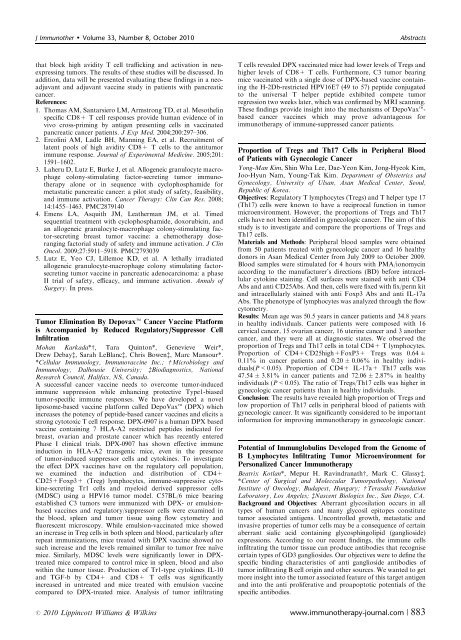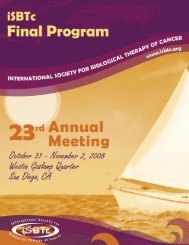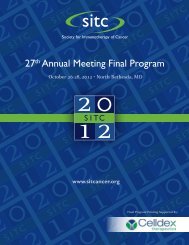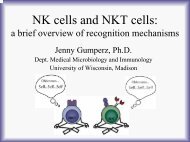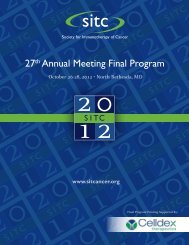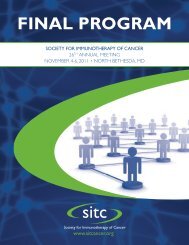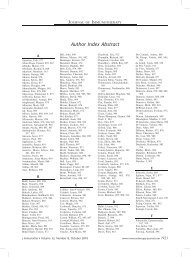Abstracts for the 25th Annual Scientific Meeting of the International ...
Abstracts for the 25th Annual Scientific Meeting of the International ...
Abstracts for the 25th Annual Scientific Meeting of the International ...
You also want an ePaper? Increase the reach of your titles
YUMPU automatically turns print PDFs into web optimized ePapers that Google loves.
J Immuno<strong>the</strong>r Volume 33, Number 8, October 2010<br />
<strong>Abstracts</strong><br />
that block high avidity T cell trafficking and activation in neuexpressing<br />
tumors. The results <strong>of</strong> <strong>the</strong>se studies will be discussed. In<br />
addition, data will be presented evaluating <strong>the</strong>se findings in a neoadjuvant<br />
and adjuvant vaccine study in patients with pancreatic<br />
cancer.<br />
References:<br />
1. Thomas AM, Santarsiero LM, Armstrong TD, et al. Meso<strong>the</strong>lin<br />
specific CD8+ T cell responses provide human evidence <strong>of</strong> in<br />
vivo cross-priming by antigen presenting cells in vaccinated<br />
pancreatic cancer patients. J Exp Med. 2004;200:297–306.<br />
2. Ercolini AM, Ladle BH, Manning EA, et al. Recruitment <strong>of</strong><br />
latent pools <strong>of</strong> high avidity CD8+ T cells to <strong>the</strong> antitumor<br />
immune response. Journal <strong>of</strong> Experimental Medicine. 2005;201:<br />
1591–1602.<br />
3. Laheru D, Lutz E, Burke J, et al. Allogeneic granulocyte macrophage<br />
colony-stimulating factor-secreting tumor immuno<strong>the</strong>rapy<br />
alone or in sequence with cyclophosphamide <strong>for</strong><br />
metastatic pancreatic cancer: a pilot study <strong>of</strong> safety, feasibility,<br />
and immune activation. Cancer Therapy: Clin Can Res. 2008;<br />
14:1455–1463. PMC2879140<br />
4. Emens LA, Asquith JM, Lea<strong>the</strong>rman JM, et al. Timed<br />
sequential treatment with cyclophosphamide, doxorubicin, and<br />
an allogeneic granulocyte-macrophage colony-stimulating factor-secreting<br />
breast tumor vaccine: a chemo<strong>the</strong>rapy doseranging<br />
factorial study <strong>of</strong> safety and immune activation. J Clin<br />
Oncol. 2009;27:5911–5918. PMC2793039<br />
5. Lutz E, Yeo CJ, Lillemoe KD, et al. A lethally irradiated<br />
allogeneic granulocyte-macrophage colony stimulating factorsecreting<br />
tumor vaccine in pancreatic adenocarcinoma: a phase<br />
II trial <strong>of</strong> safety, efficacy, and immune activation. Annals <strong>of</strong><br />
Surgery. In press.<br />
Tumor Elimination By Depovaxt Cancer Vaccine Plat<strong>for</strong>m<br />
is Accompanied by Reduced Regulatory/Suppressor Cell<br />
Infiltration<br />
Mohan Karkada*w, Tara Quinton*, Genevieve Weir*,<br />
Drew Debayz, Sarah LeBlancz, Chris Bowenz, Marc Mansour*.<br />
*Cellular Immunology, Immunovaccine Inc.; w Microbiology and<br />
Immunology, Dalhousie University; zBiodiagnostics, National<br />
Research Council, Halifax, NS, Canada.<br />
A successful cancer vaccine needs to overcome tumor-induced<br />
immune suppression while enhancing protective Type1-biased<br />
tumor-specific immune responses. We have developed a novel<br />
liposome-based vaccine plat<strong>for</strong>m called DepoVaxt (DPX) which<br />
increases <strong>the</strong> potency <strong>of</strong> peptide-based cancer vaccines and elicits a<br />
strong cytotoxic T cell response. DPX-0907 is a human DPX based<br />
vaccine containing 7 HLA-A2 restricted peptides indicated <strong>for</strong><br />
breast, ovarian and prostate cancer which has recently entered<br />
Phase I clinical trials. DPX-0907 has shown effective immune<br />
induction in HLA-A2 transgenic mice, even in <strong>the</strong> presence<br />
<strong>of</strong> tumor-induced suppressor cells and cytokines. To investigate<br />
<strong>the</strong> effect DPX vaccines have on <strong>the</strong> regulatory cell population,<br />
we examined <strong>the</strong> induction and distribution <strong>of</strong> CD4+<br />
CD25+Foxp3+ (Treg) lymphocytes, immune-suppressive cytokine-secreting<br />
Tr1 cells and myeloid derived suppressor cells<br />
(MDSC) using a HPV16 tumor model. C57BL/6 mice bearing<br />
established C3 tumors were immunized with DPX- or emulsionbased<br />
vaccines and regulatory/suppressor cells were examined in<br />
<strong>the</strong> blood, spleen and tumor tissue using flow cytometry and<br />
fluorescent microscopy. While emulsion-vaccinated mice showed<br />
an increase in Treg cells in both spleen and blood, particularly after<br />
repeat immunizations, mice treated with DPX vaccine showed no<br />
such increase and <strong>the</strong> levels remained similar to tumor free naı¨ ve<br />
mice. Similarly, MDSC levels were significantly lower in DPXtreated<br />
mice compared to control mice in spleen, blood and also<br />
within <strong>the</strong> tumor tissue. Production <strong>of</strong> Tr1-type cytokines IL-10<br />
and TGF-b by CD4+ and CD8+ T cells was significantly<br />
increased in untreated and mice treated with emulsion vaccine<br />
compared to DPX-treated mice. Analysis <strong>of</strong> tumor infiltrating<br />
T cells revealed DPX vaccinated mice had lower levels <strong>of</strong> Tregs and<br />
higher levels <strong>of</strong> CD8+ T cells. Fur<strong>the</strong>rmore, C3 tumor bearing<br />
mice vaccinated with a single dose <strong>of</strong> DPX-based vaccine containing<br />
<strong>the</strong> H-2Db-restricted HPV16E7 (49 to 57) peptide conjugated<br />
to <strong>the</strong> universal T helper peptide exhibited compete tumor<br />
regression two weeks later, which was confirmed by MRI scanning.<br />
These findings provide insight into <strong>the</strong> mechanisms <strong>of</strong> DepoVaxtbased<br />
cancer vaccines which may prove advantageous <strong>for</strong><br />
immuno<strong>the</strong>rapy <strong>of</strong> immune-suppressed cancer patients.<br />
Proportion <strong>of</strong> Tregs and Th17 Cells in Peripheral Blood<br />
<strong>of</strong> Patients with Gynecologic Cancer<br />
Yong-Man Kim, Shin Wha Lee, Dae-Yeon Kim, Jong-Hyeok Kim,<br />
Joo-Hyun Nam, Young-Tak Kim. Department <strong>of</strong> Obstetrics and<br />
Gynecology, University <strong>of</strong> Ulsan, Asan Medical Center, Seoul,<br />
Republic <strong>of</strong> Korea.<br />
Objectives: Regulatory T lymphocytes (Tregs) and T helper type 17<br />
(Th17) cells were known to have a reciprocal function in tumor<br />
microenvironment. However, <strong>the</strong> proportions <strong>of</strong> Tregs and Th17<br />
cells have not been identified in gynecologic cancer. The aim <strong>of</strong> this<br />
study is to investigate and compare <strong>the</strong> proportions <strong>of</strong> Tregs and<br />
Th17 cells.<br />
Materials and Methods: Peripheral blood samples were obtained<br />
from 50 patients treated with gynecologic cancer and 16 healthy<br />
donors in Asan Medical Center from July 2009 to October 2009.<br />
Blood samples were stimulated <strong>for</strong> 4 hours with PMA/ionomycin<br />
according to <strong>the</strong> manufacturer’s directions (BD) be<strong>for</strong>e intracellular<br />
cytokine staining. Cell surfaces were stained with anti CD4<br />
Abs and anti CD25Abs. And <strong>the</strong>n, cells were fixed with fix/perm kit<br />
and intracellularly stained with anti Foxp3 Abs and anti IL-17a<br />
Abs. The phenotype <strong>of</strong> lymphocytes was analyzed through <strong>the</strong> flow<br />
cytometry.<br />
Results: Mean age was 50.5 years in cancer patients and 34.8 years<br />
in healthy individuals. Cancer patients were composed with 16<br />
cervical cancer, 15 ovarian cancer, 16 uterine cancer and 3 ano<strong>the</strong>r<br />
cancer, and <strong>the</strong>y were all at diagnostic states. We observed <strong>the</strong><br />
proportion <strong>of</strong> Tregs and Th17 cells in total CD4+ T lymphocytes.<br />
Proportion <strong>of</strong> CD4+CD25high+FoxP3+ Tregs was 0.64 ±<br />
0.11% in cancer patients and 0.20 ± 0.06% in healthy individuals(P


